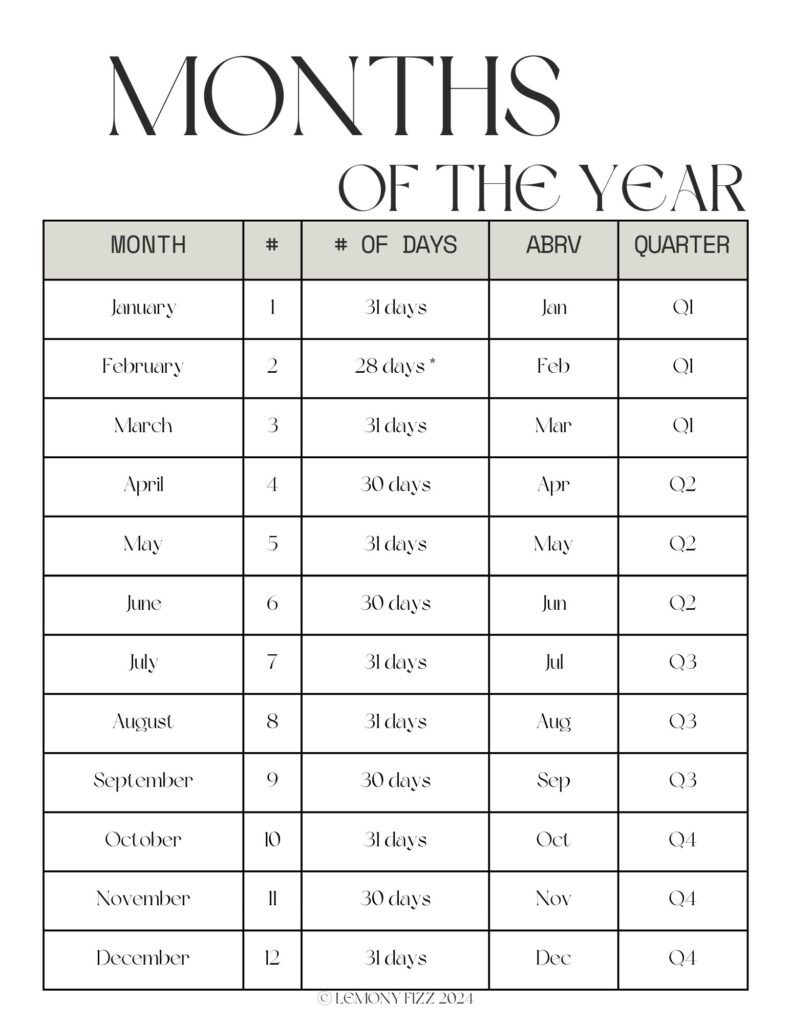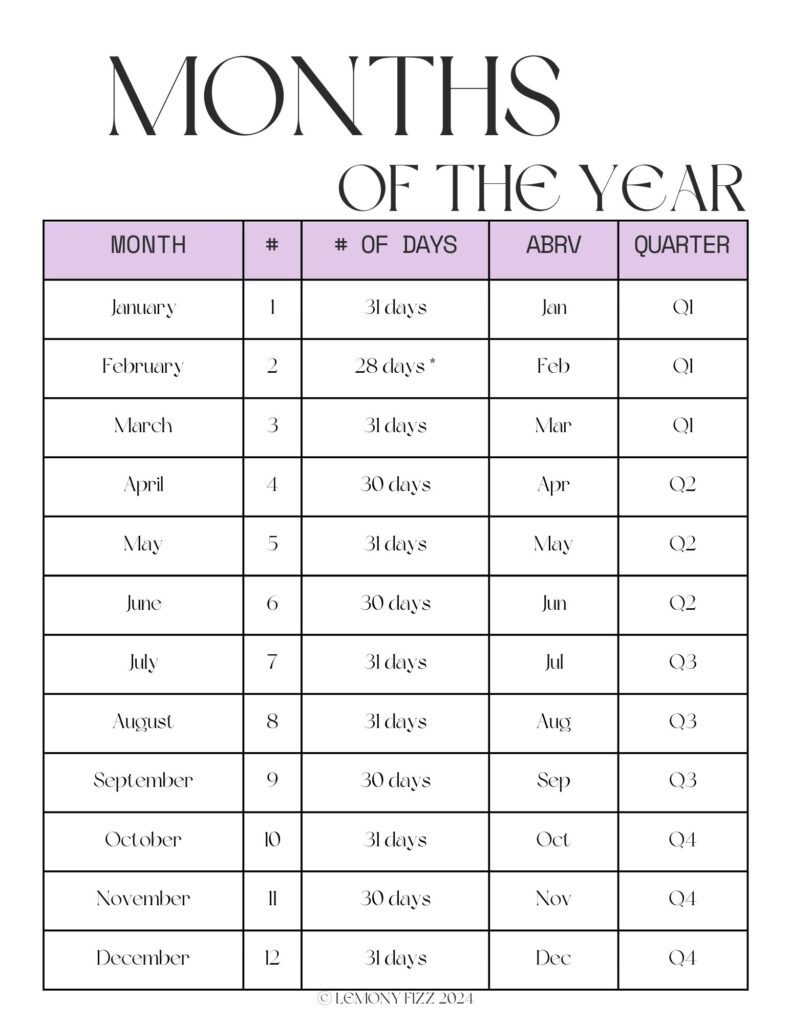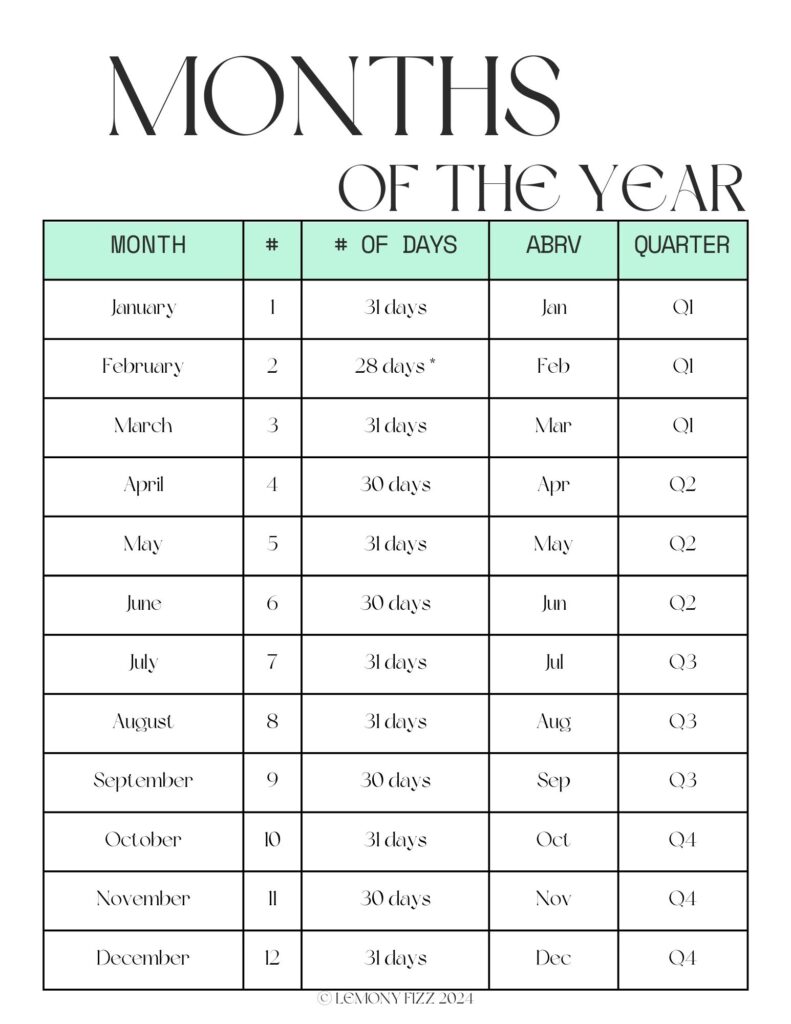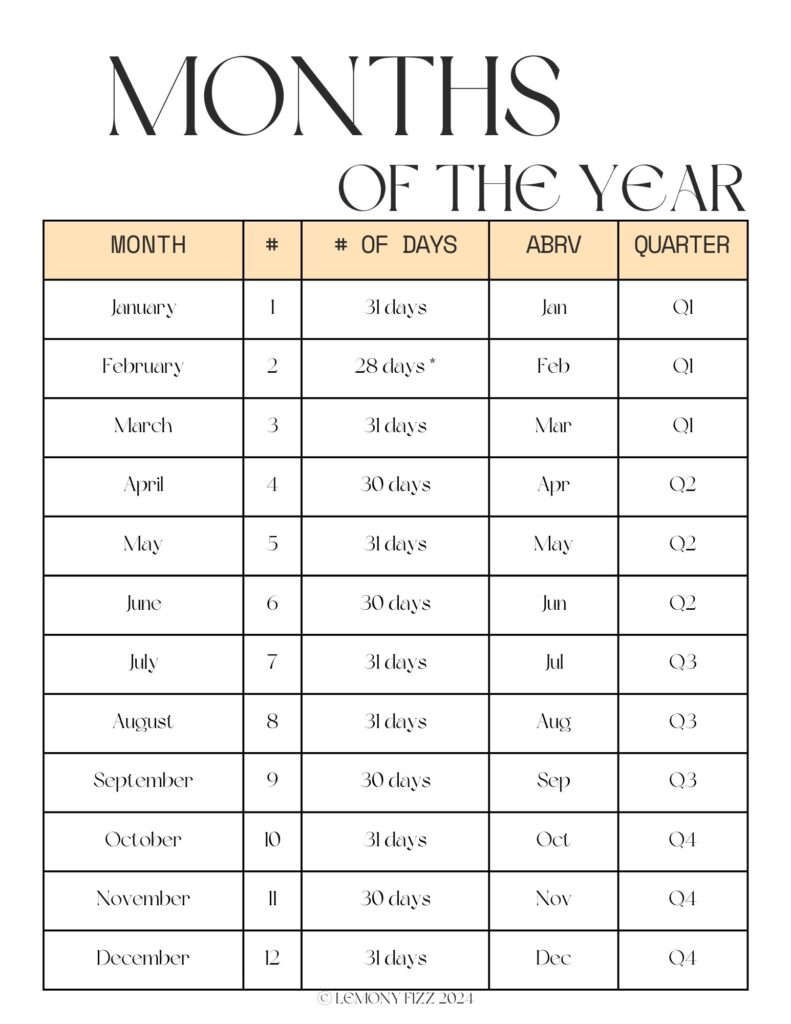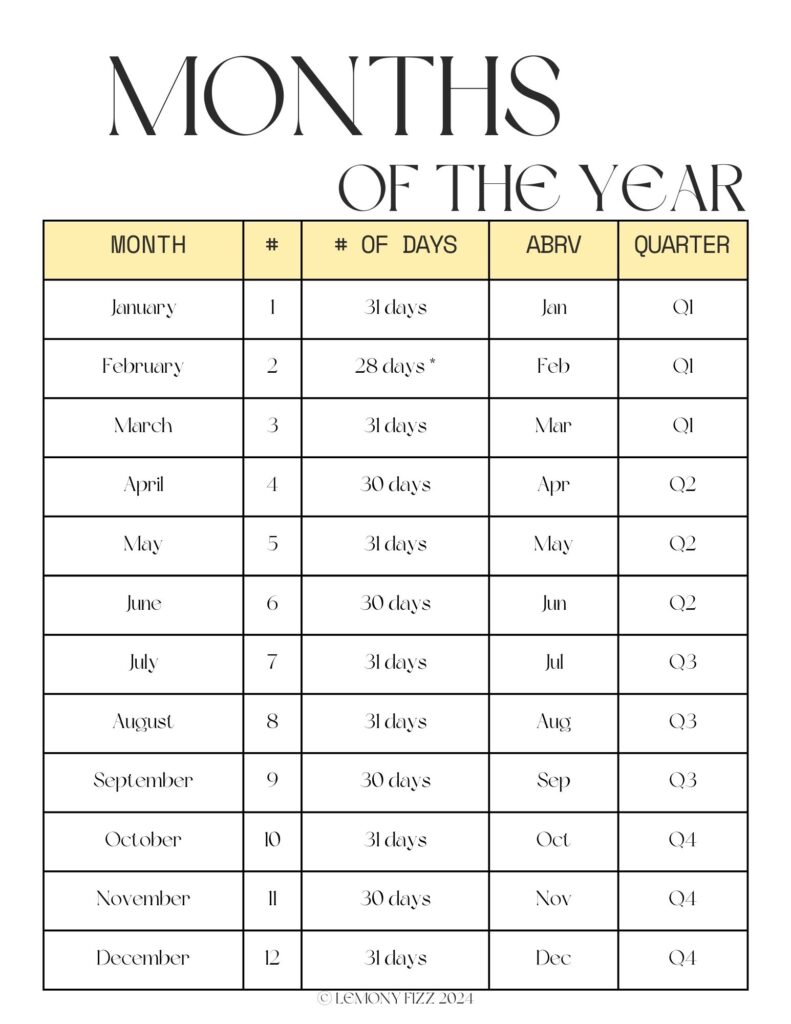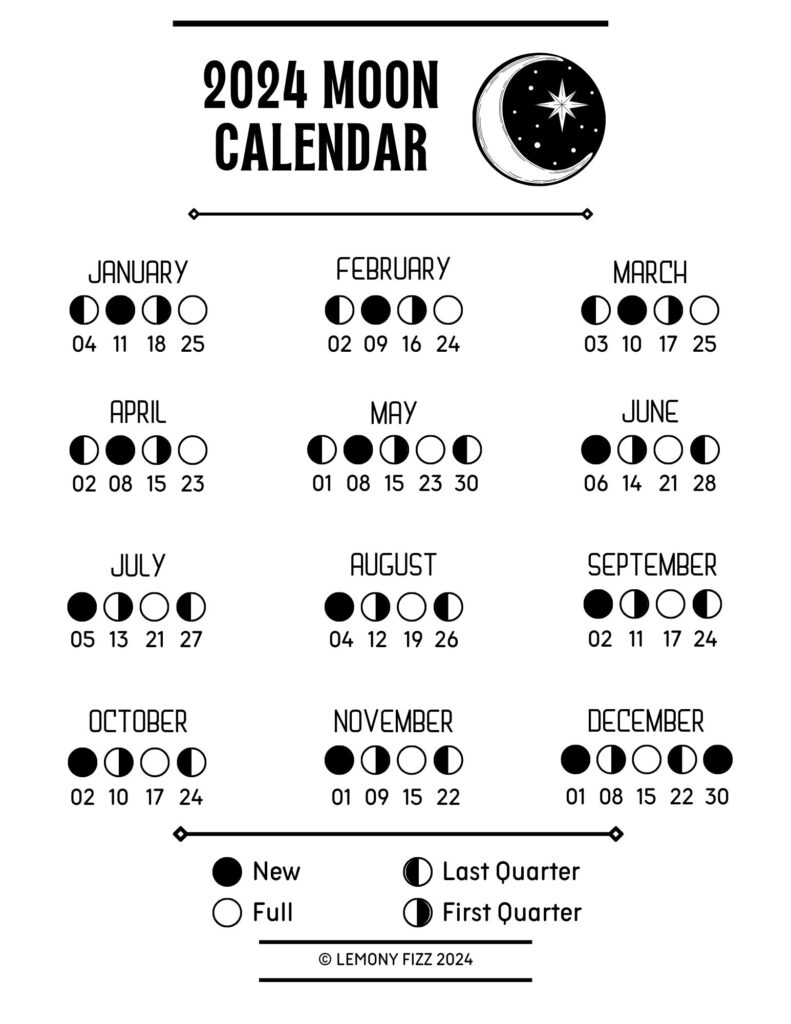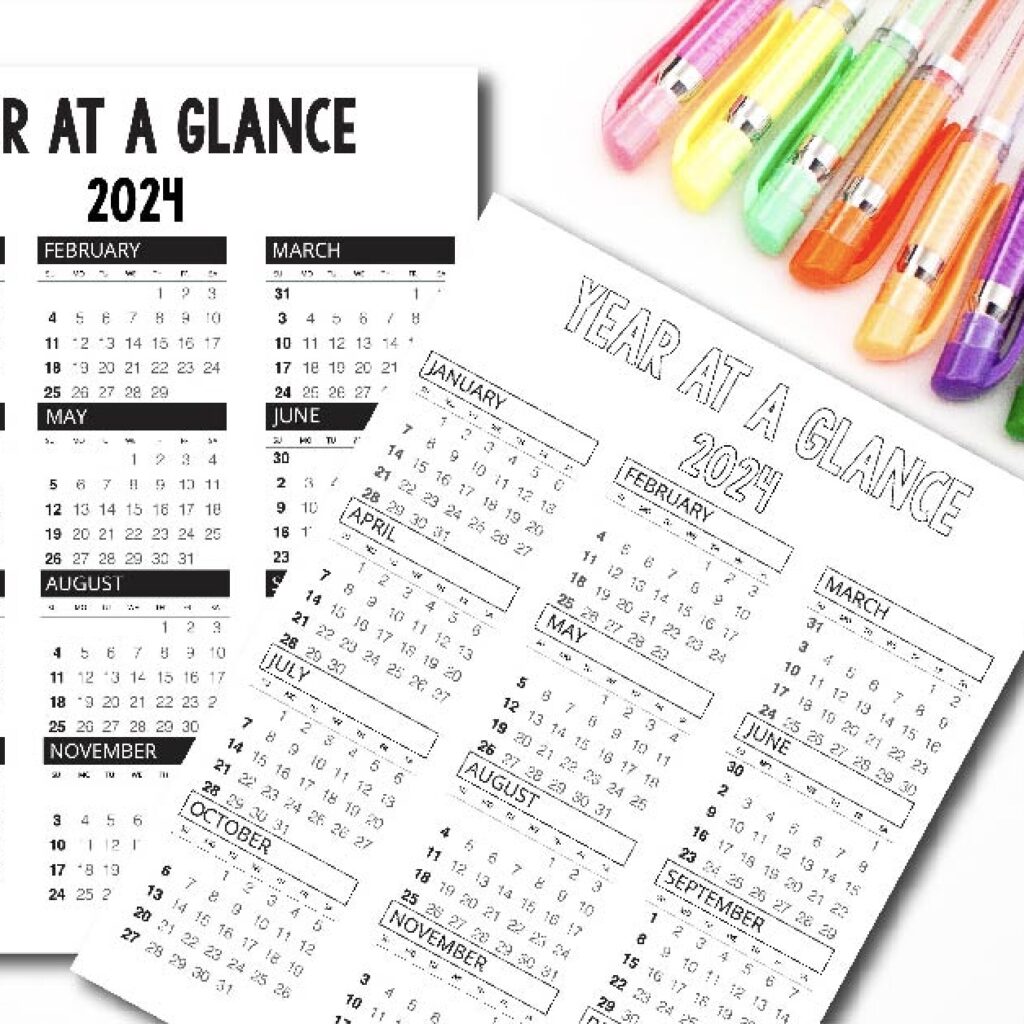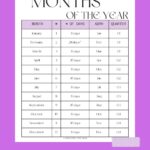The Months of the Year: A List of the Months in Order
We may earn a small commission for purchases made through affiliate links in this post. For more information go to our Privacy Policy.
Today’s Date is:
Friday, July 26, 2024
mm/dd/yy format : 07/26/2024
dd/mm/yy format: 26/07/2024
mm (month), dd (day), yy (year)
Months of the Year – List of Months in Order
It’s a curiosity that spans centuries. How did the Gregorian calendar come to delineate time into the 12 months we now know so well? Nestled in a history rich with cultural evolution and astronomical precision, the division of the year was no small feat.
From the Roman calendar to its Julian predecessor, each month was meticulously crafted to align with both the solar year and significant celestial events like equinoxes and solstices. Leap years further refine this alignment, ensuring our calendar stays in tune with the Earth’s orbit around the sun.
So, as we navigate through each lunar month, bear in mind the astronomical and historical tapestry that weaves our current understanding of time.
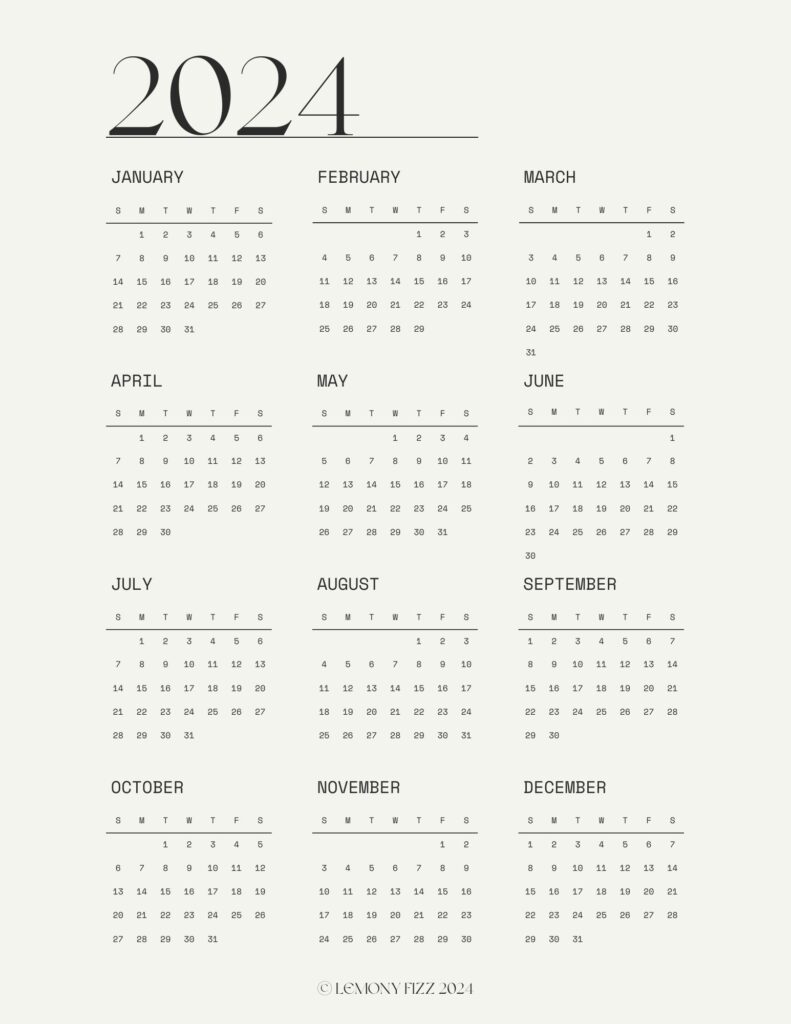
Today’s Month Number Is:
| Month Number | Month Name | Days in Month | Abbrv. | Quarter | Season (Northern) |
|---|---|---|---|---|---|
| 1 | January | 31 days | Jan. | Q1 | Winter |
| 2 | February | 28 days 29 days (leap year) | Feb. | Q1 | Winter |
| 3 | March | 31 days | Mar. | Q1 | Spring |
| 4 | April | 30 days | Apr. | Q2 | Spring |
| 5 | May | 31 days | May. | Q2 | Spring |
| 6 | June | 30 days | Jun. | Q2 | Summer |
| 7 | July | 31 days | Jul. | Q3 | Summer |
| 8 | August | 31 days | Aug. | Q3 | Summer |
| 9 | September | 30 days | Sep. | Q3 | Autumn |
| 10 | October | 31 days | Oct. | Q4 | Autumn |
| 11 | November | 30 days | Nov. | Q4 | Autumn |
| 12 | December | 31 days | Dec. | Q4 | Winter |
The Months of the Year List – All the Months in Order
It’s like taking a trip around the sun, really. The Gregorian calendar, our trusty guide through the days, gives us 12 months to journey through.
Starting with the chilly embrace of January, we meander into the budding promise of February, before stepping into the fresh blooms of March. April showers bring May flowers, leading us into the sun-kissed days of June.
The height of summer in July eventually cools into the breezy days of August, setting the stage for the golden hues of September.
October brings a whisper of change, gently laying us into the crisp lap of November, before the quiet hush of December wraps us in a blanket of frosty stars. Then we wrap back around into the first month of the year, January.
List of Months
How Many Months in a Year? – The Number of Months in a Year
There are 12 months in a year.
It’s a pretty straightforward fact, isn’t it? In the realm of the Gregorian calendar, the system that orchestrates our day-to-day life, there are always 12 months in a year. No more, no less. This arrangement, known the world over, segments our year into these 12 distinct periods, each playing its part in the cyclical rhythm of life.
So, whether you’re planning for the leap year 2024, marking the date for the Harvest Moon 2024, or just curious about the number of weeks in a month, it’s this calendar, with its roots deep in history and astronomy, that keeps us in sync with the solar year and the astronomical seasons marked by equinoxes and solstices.
Get your year at a glance calendars and print them out for your planners or journals (or just hang them in your office space as a quick reference).
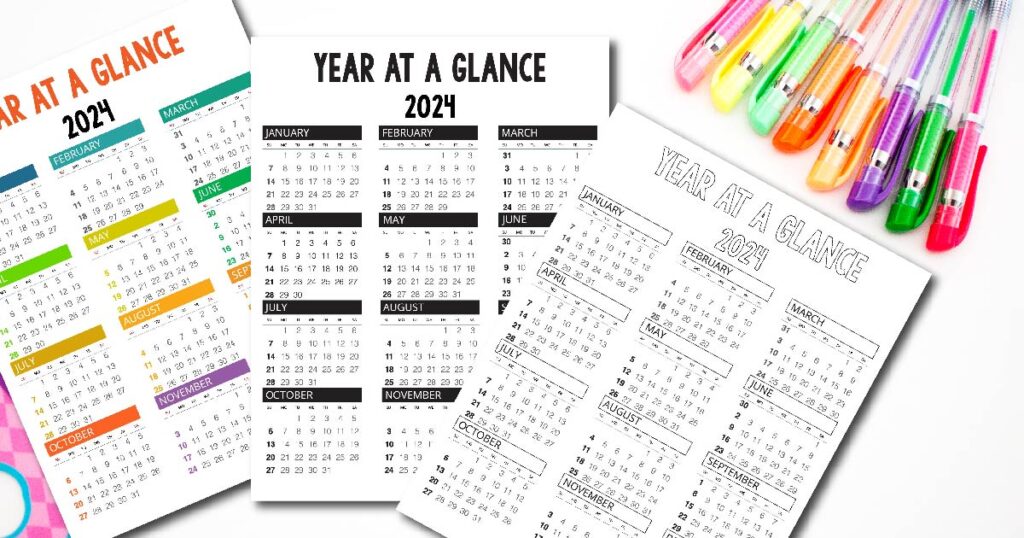
How Many Days in Each Month – The Number of Days in a Month
Ever noticed how the months keep you on your toes with their ever-changing number of days?
Diving into the Gregorian calendar, we find a quirky spread – some months packing a solid 31 days, those modest 30-day stretches, and February, that keeps us guessing with 28 or 29 days, thanks to the leap year dance.
It’s all about sync with solar years, equinoxes, and solstices.
Longest Day of the Year (Northern Hemisphere)
Summer Equinox: June 20, 2024
We are the closest to the sun and the tilt of the earth means we have more daylight hours than darkness (in the Northern Hemisphere, it is the complete opposite in the Southern Hemisphere).
Shortest Day of the Year (Northern Hemisphere)
Winter Equinox: December 21, 2024
We are the farthest from the sun and the tilt of the earth means we have more dark hours than light (in the Northern Hemisphere, it is the complete opposite in the Southern Hemisphere).
Months with 28 (or 29) Days
- February
So here’s a quirky thing about our calendar: February stands out by being the only month with 28 days, and it throws in a curveball every leap year by flaunting an extra day, making it 29 days long.
Now, you might wonder, why mess with February? It’s all about keeping our calendar in harmony with the Earth’s journey around the sun, ensuring leap years help correct our time tracking every four years.
Months with 30 Days
- April
- June
- September
- November
Months with 31 Days
- January
- March
- May
- July
- August
- October
- December
It’s a curious thing, really, how the Gregorian calendar lays out the days and months.
Seven months of the year, those being January, March, May, July, August, October, and December, generously offer us 31 days each.
That’s the majority of the calendar year, giving us more time to enjoy, celebrate, or simply get things done. It’s like an extra treat or a bonus round in the game of life, isn’t it? These months serve as pillars, supporting the structure of our year in a way that feels both balanced and plentiful.
Thirty Days Hath September Mnemonic Device
Thirty days has September,
April, June, and November,
All the rest have thirty-one,
Save February at twenty-eight,
But leap year, coming once in four,
February then has one day more.
Memorizing a mneumonic device or rhyming chant can help you to recall which months of the year have 30 days and which have 31. And that February is an exception. This particular poem has been found in manuscripts dating back as far as 1555 A.D.
And How Many Weeks Are There in a Month?
It’s a curious thing, really, when you start to puzzle over how many weeks there are in a month. You see, this isn’t a one-size-fits-all answer. Generally, we’re looking at somewhere between 4 to 5 weeks, but it’s all about how those days line up on the calendar.
Leap Years Explained
Ever stumbled upon the enigmatic leap year and wondered about its magic in syncing our calendar perfectly with Earth’s journey around the sun?
It’s like a secret ingredient, ensuring our Gregorian calendar, with its 12 months and varying days in a month, stays in rhythm with the solar year.
Leap years, marked by the extra day, February 29, fine-tune this harmony, bridging the gap between our human-made constructs and the celestial dance of equinoxes and solstices.
So, in 2024, as we tack on an additional day, it’s a subtle nod to the astronomical seasons, ensuring our calendar remains an accurate echo of Earth’s solar orbit.
What Are Leap Years?
So, what’s the deal with leap years? You might have noticed that every so often, February decides to steal an extra day.
This isn’t random chaos but a critical correction to keep our Gregorian calendar in line with the solar year. See, our planet doesn’t orbit the sun in a neat 365 days but roughly 365.25 days.
Without an extra day—yep, that famous February 29—our seasons would slowly drift. Imagine Christmas in spring! Leap years ensure our calendar remains aligned with astronomical seasons, emphasizing the importance of both solar and lunar measurements in time-keeping.
Is the Year 2024 a Leap Year?
Yes, it absolutely is.
Here’s the scoop: leap years, like 2024, come around every 4 years to ensure our calendar stays in lockstep with the astronomical seasons. Without them, we’d slowly drift away from the solar year and our calendar wouldn’t be as accurate.
Oh, the leap year, it’s such a curious thing, isn’t it? Almost feels like a bonus day thrown our way. But if you’re scratching your head, wondering when you’ll get that extra day again, fret not. We’ve got you covered with a list of the next few leap years, just so you can mark them on your Gregorian calendar. So, grab your calendars, because here they come:
- 2028 is up next, adding an extra day to February, making it 29 days long.
- 2032 follows, keeping our calendar in perfect harmony with the Earth’s orbit around the sun.
- 2036 continues the tradition, guaranteeing that our astronomical seasons stay aligned with our Gregorian calendar.
What Were the Past Leap Years?
Have you ever wondered about the rhythm behind our years? Let’s take a moment to appreciate the leap year phenomenon which keeps us in sync with the astronomical seasons. The past leap years, those extra days added to our calendars, include 2020, 2016, and 2012. These years were special, each with a February 29, granting us an additional day to ensure our calendar aligns perfectly with the Earth’s orbit around the sun.
How Do You Know If a Year Is a Leap Year?
If the calendar has the day February 29th (Leap Day), then the year is a leap year.
How to Remember Which Year Is a Leap Year?
Ever found yourself puzzled, wondering, “How do I figure out if it’s a leap year?”
It’s simpler than you may think! Here’s the golden rule: if the year can be evenly divided by 4, you’ve got yourself a leap year.
Ah, but wait! There’s a twist for those century years. Despite their divisible by 4 status, they must also be divisible by 400. So, 2000 was a leap year, but 1900? Not so much.
Keep this tidbit handy for the next trivia night or whenever you’re planning ahead for that extra day in February.
What Are the 12 Months in Order?
It’s like stepping into a time machine when we talk about the Gregorian calendar and its meticulously arranged 12 months. Do you ever stop and marvel at how historically calendars were designed to mark time?
We find ourselves navigating through these neatly partitioned sections of the year, from the chilly beginnings in January to the festive end in December.
- January, initiating the cycle, a fresh start for many,
- February, the only one playing leap year tricks with its days,
- March, where we start to see the blossoms of spring,
- April, showering us with unpredictable weather,
- May, the gate to summer vibes and longer days,
- June, truly ushering us into summer’s arms,
- July, when the heat truly takes hold,
- August, preparing us for the turn of season,
- September, where the air starts to crisp,
- October, bringing the harvest and halloween fun,
- November, the time of giving thanks and reflection,
- December, closing the year with cheer and celebration.
What Are the Numbers for Each Month?
What Is the First Month of the Year?
Ah, January, you’re like the Monday of the calendar, signaling a fresh start for all of us.
The January month number is 1. January is the first month of the year.
January comes after December and before February.
January 1st is known as New Year‘s Day, which is when the new calendar year begins.
The number of days in January is 31.
What Month Is February?
The February month number is 2. February is the second month of the year.
February comes after January and before March.
The number of days in February is 28. Every fourth year (Leap Year) the number of days is 29.
What Is the March Month Number?
The March month number is 3. March is the third month of the year.
March comes after February and before April.
The number of days in March is 31.
What Is the April Month Number?
The April month number is 4. April is the fourth month of the year.
April comes after March and before May.
The number of days in April is 30.
What Month Is May?
The May month number is 5. May is the fifth month of the year.
May comes after April and before June.
The number of days in May is 31.
What Month Number is June?
The June month number is 6. June is the sixth month of the year.
June comes after May and before July.
The number of days in June is 30.
What Number is July?
The July month number is 7. July is the seventh month of the year.
July comes after June and before August.
The number of days in July is 31.
What month is August?
The August month number is 8. August is the eighth month of the year.
August comes after July and before September.
The number of days in August is 31.
What is the September month number?
The September month number is 9. September is the ninth month of the year.
September comes after August and before October.
The number of days in September is 30.
What number is October?
The October month number is 10. October is the tenth month of the year.
October comes after September and before November.
The number of days in October is 31.
What is the November month number?
The November month number is 1. August is the eleventh month of the year.
November comes after October and before December.
The number of days in November is 30.
What number month is December?
The December month number is 12. August is the twelfth month of the year.
December comes after November and before January.
The number of days in December is 31.
The names of the months – Where the names of the months come from?
The origins of the month names reveal fascinating connections to ancient beliefs and cultural practices.
January, derived from the Latin Ianuarius, honors Janus, the Roman god symbolizing reflection on the past and anticipation of the future.
February, or Februarius in Latin, pays homage to the Roman festival of purification, Februa.
March, from the Latin Martius, is named after the Roman god Mars.
April (Aprilis or Mensis Aprilis in Latin) might trace its roots to “aperire,” signifying the opening of spring, or the Greek goddess Venus’ equivalent, Aphrodite.
May (Maius or Mensis Maius in Latin) takes inspiration from the Greek goddess Maia, linked to the Roman Goddess of Fertility, Bona Dea.
June (Junius or Mensis Junius in Latin) is dedicated to the Roman goddess Juno, wife of Jupiter, the king of gods.
July (Iūlius in Latin) honors Julius Caesar posthumously, previously known as Quintilis in the 10-month calendar.
August (Augustus in Latin) commemorates the first Roman emperor, Augustus, formerly Sextilis in the 10-month calendar.
September (September or Mensis September in Latin) reflects its historical position as the seventh month.
October (October or Mensis October in Latin) finds its origin in the word ôctō, representing its past status as the eighth month.
November (November or Mensis November in Latin) hearkens back to its role as the ninth month, originating from the Latin word novem.
December (December or Mensis December in Latin) preserves its history as the tenth and final month, originating from the Latin word decem, meaning ten.
Lunar Calendar – The origin of months: moon’s orbit
The calendar’s correspondence to the moon cycle is an intricate dance between the Earth, the Sun, and the Moon. Traditionally, many early calendars were based on the lunar cycle, reflecting the phases of the Moon as it orbits the Earth, or the lunar cycle.
The word “month” is derived from the Latin word mensis.
A lunar month, also known as a synodic month, is the time it takes for the Moon to complete its full cycle of phases, from new moon to new moon. This period averages around 29.5 days. Early lunar calendars were often tied to this cycle, with months beginning at the sighting of the new moon.
However, aligning a lunar calendar with the solar year (the time it takes for Earth to complete one orbit around the Sun) posed challenges. A pure lunar calendar would result in a misalignment with the seasons over time. To address this, some cultures incorporated adjustments, intercalating extra days or months to reconcile the lunar and solar cycles.
Consequently, various calendar systems evolved, such as lunisolar calendars, which combine elements of both lunar and solar reckoning. Examples include the Hebrew calendar and the traditional Chinese calendar. These systems maintain a connection to the lunar phases while ensuring synchronization with the solar year, offering a harmonious interplay between the celestial bodies and our measurement of time.
The Moon Phases
- New moon: when the moon is not visible from Earth because it is between Earth and the Sun.
- First-quarter: when one-fourth of the moon’s surface is illuminated by the Sun.
- Full moon: when the moon is fully illuminated by the Sun.
- Last quarter: when one-fourth of the moon’s surface is illuminated by the Sun.
There are also other moon phases like Waxing Gibbous and Waning Gibbous Moon and Waxing Crescent and Waning Crescent Moon.
It’s more than just tracking days; it’s the beat of the cosmos, a measure that guided farming, festivals, and the very flow of human life.
History of the months – Roman Calendar & Julian calendar
The Roman calendar, initially comprising ten months and commencing with March (the first month) through December (the final month), underwent significant modifications over time. Numa Pompilius, a Roman ruler, is credited with expanding the calendar to twelve months by incorporating January and February.
Julius Caesar, in 45 BC, ushered in the Julian calendar as a reform of its predecessor. This revised calendar featured a year length of 365.25 days. The innovative structure accounted for leap years, with every fourth year encompassing 366 days, maintaining a more accurate alignment with the solar year.
The Modern-day Calendar: Gregorian Calendar
The prevalent calendar in use today is the Gregorian Calendar, introduced by Pope Gregory XIII in 1582 and rooted in the Julian calendar.
The Julian calendar, with a year length of 365.25 days, slightly deviated from the more precise solar year of 365.24219 days. Pope Gregory XIII refined this by adjusting the year length to 365.2425 days, a seemingly subtle alteration.
However, over time, the Julian calendar, being 10.8 minutes longer, accumulates an extra day every 128 years compared to the Gregorian calendar.
This seemingly minor adjustment results in the Julian calendar falling 13 days behind the Gregorian calendar, highlighting its significance.
The Gregorian calendar stands as the most widely used calendar globally, although other calendars persist for computing religious holidays and annual festivities. For the tracking of days, weeks, months, and years, the Gregorian calendar remains the predominant choice.
Printable yearly calendars?
It’s a bit like magic, isn’t it? The way you can just print out printable yearly calendars from the comfort of your own home. Gone are the days of waiting for a new year to kick in or running to the store just to keep up with the Gregorian calendar.
Now, in just a few clicks, we can have an entire year laid out before us, each month perfectly aligned with all its astronomical seasons, from equinoxes to solstices.
Monthly calendars to print out
Gather up those months, print out calendars, and dive into planning with joy.
Choose your style and print it as needed.

